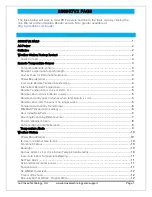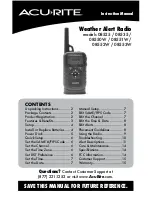
La Crosse Technology, Ltd. www.lacrossetechnology.com/support
Page 9
•
Sometimes a simple relocation of the remote sensor or the weather station will correct
the interference.
•
Windows can reflect the radio signal.
•
Metal will absorb the RF (radio frequency) signal.
•
Stucco has a metal mesh that absorbs signal.
•
Avoid transmitting antennas: (ham radios, emergency dispatch centers, airports, military
bases, etc.)
•
Electrical wires (utilities, cable, etc.)
•
Vegetation is full of moisture and reduces signal.
•
It is difficult for RF (radio frequency) signal to travel through a hill.
Temperature Alerts
Explanation: The remote and indoor temperature alerts are set in two separate steps.
•
Set the alert value.
•
Arm/Disarm the alert.
Select Temperature Alert Values:
Hold the ALERT button for five seconds to select and set temperature alert values.
1.
REMOTE HI alert will flash. Press the ▲ or ▼ buttons to set the alert value and press the
ALERT button to confirm. Then press the ALERT button again switch to REMOTE LO
setting.
2.
REMOTE LO alert will flash. Press the ▲ or ▼ buttons to set the alert value and press
the ALERT button to confirm. Then press the ALERT button again switch to INDOOR HI
setting.
3.
INDOOR HI alert will flash. Press the ▲ or ▼ buttons to set the value and press the
ALERT button to confirm and switch to INDOOR LO.
4.
INDOOR LO alert will flash. Press the ▲ or ▼ buttons to set the alert value and press
the ALERT button to confirm. Then press the ALERT button again confirm and exit.
Note: After selecting temperature alert values, use the next step to arm or disarm
individual alerts.
Temperature Alerts ON/OFF
•
In normal mode, press the ALERT button to toggle between:
o
Remote HI
o
Remote LO
o
Indoor HI
o
Indoor LO
•
Press the ▲ button to arm the selected alert.
•
The alert icon (bell) appears next to the alert, when the alert is active.
•
Press the ▼ button to disarm the selected alert.
Note: When no temperature alerts are set, the Temperature Alert area will show OFF.
































